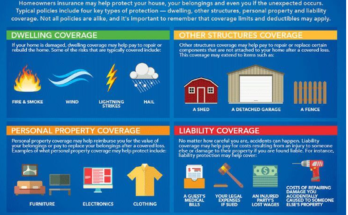The Cost of Home Insurance: What Influences Your Premium?
Home insurance is a critical aspect of homeownership that provides financial protection against unexpected events such as theft, fire, and natural disasters. Understanding the cost of home insurance and the factors influencing your premium is essential for homeowners and potential buyers. This comprehensive guide will explore what home insurance entails, how premiums are determined, the various features of home insurance policies, and strategies for managing your costs effectively.
What is The Cost of Home Insurance: What Influences Your Premium?
Home insurance, also known as homeowners insurance, is a type of property insurance that covers losses and damages to an individual’s residence. This insurance provides financial compensation for damage to the home and its contents, as well as liability coverage for accidents that occur on the property.
The cost of home insurance premiums can vary significantly based on several factors. Understanding these influences helps homeowners make informed decisions when selecting coverage and providers. Here are the primary factors that can affect your home insurance premium:
- Location of the Home: Homes in areas prone to natural disasters, such as hurricanes or floods, typically have higher premiums.
- Home’s Characteristics: The age, size, and condition of the home play a crucial role in determining the premium.
- Coverage Options: The amount of coverage and type of policy selected will influence the cost. Policies with lower deductibles generally result in higher premiums.
- Personal Factors: Your credit score, claims history, and even your age can impact how much you pay for home insurance.
How The Cost of Home Insurance: What Influences Your Premium? Work
Understanding how home insurance premiums are calculated can empower homeowners to make better choices. Here’s an overview of how the process works:
- Risk Assessment: Insurance companies evaluate the risk associated with insuring a property based on its location, age, and condition.
- Actuarial Data: Insurers use statistical data and models to predict the likelihood of claims. This data guides them in setting premium rates.
- Underwriting Process: This involves assessing the details of your home and your personal information. Underwriters look at your credit history, previous claims, and coverage levels to determine your final premium.
- Adjustments for Discounts: Many insurance providers offer discounts for various reasons, such as bundling multiple policies or having home security systems. These discounts can help reduce your overall premium.
Features of The Cost of Home Insurance: What Influences Your Premium?
Home insurance policies typically include several key features, which can vary by provider. Understanding these features will help you choose the right coverage for your needs:
- Dwelling Coverage: This covers the structure of your home against risks like fire, wind, and theft. The amount should ideally reflect the rebuilding cost.
- Personal Property Coverage: This feature covers personal belongings within the home, such as furniture, electronics, and clothing, against loss or damage.
- Liability Coverage: This protects you if someone gets injured on your property and decides to sue. It typically covers legal fees and any settlements.
- Additional Living Expenses (ALE): If your home becomes uninhabitable due to a covered event, this coverage pays for living expenses like hotel bills and meals.
- Deductibles: The amount you pay out of pocket before your insurance kicks in. Higher deductibles generally lead to lower premiums.
- Optional Endorsements: These are additional coverages you can add to your policy for a fee, such as coverage for valuable items (jewelry, art) or home office equipment.
Pros of The Cost of Home Insurance: What Influences Your Premium?
| Pros | Details |
|---|---|
| Financial Protection | Provides coverage against significant financial losses from damages or liability claims. |
| Peace of Mind | Knowing that your home and belongings are protected can reduce stress for homeowners. |
| Liability Coverage | Protects against lawsuits for injuries or damages that occur on your property. |
| Customization Options | Policies can often be tailored to fit individual needs through endorsements and additional coverage options. |
| Discounts Available | Many insurers offer discounts for various factors, such as bundling with auto insurance or having security features. |
Cons of The Cost of Home Insurance: What Influences Your Premium?
| Cons | Details |
|---|---|
| Cost Variability | Premiums can vary significantly based on location, property characteristics, and personal factors. |
| Complex Terms | The fine print of policies can be complicated, making it difficult to understand coverage details. |
| Exclusions | Many policies have exclusions for certain types of damage, such as flooding or earthquakes, requiring additional coverage. |
| Claims Process | The process of filing a claim can be time-consuming and may lead to disputes over payouts. |
| Regular Reviews Needed | Homeowners need to periodically review their coverage to ensure it still meets their needs, which can be cumbersome. |
The Cost of Home Insurance: What Influences Your Premium? Alternatives
If you’re considering alternatives to traditional home insurance, here are some options:
| Alternatives | Details |
|---|---|
| Renters Insurance | For those renting, this insurance protects personal property and liability without covering the building structure. |
| Umbrella Insurance | Provides additional liability coverage beyond standard homeowners or auto policies, ideal for those with significant assets. |
| Home Warranty | Covers repairs and replacements for home systems and appliances, but does not cover property damage. |
| Self-Insurance | Some homeowners opt to set aside savings to cover potential losses instead of purchasing a policy, although this carries risks. |
| Flood Insurance | Specialized coverage for homes in flood-prone areas, often required separately from standard homeowners insurance. |
Conclusion and Verdict: The Cost of Home Insurance: What Influences Your Premium?
Understanding the cost of home insurance and the factors influencing your premium is crucial for every homeowner. By knowing the key features, pros and cons, and available alternatives, you can make informed decisions that suit your financial situation and risk tolerance. Regularly reviewing your policy and comparing providers can help ensure you get the best coverage at a reasonable price.
Final Thoughts
Investing time in understanding your home insurance can save you money and provide peace of mind. Whether you’re a new homeowner or looking to reassess your current coverage, the insights shared in this guide can help you navigate the complexities of home insurance with confidence.
FAQs: The Cost of Home Insurance: What Influences Your Premium?
- What is the average cost of home insurance?
- The average cost varies widely depending on factors such as location, property type, and coverage amount. Typically, homeowners can expect to pay around $1,000 to $3,000 per year.
- How can I lower my home insurance premium?
- You can lower your premium by bundling policies, increasing deductibles, improving home security, and regularly comparing insurance providers for better rates.
- Do I need home insurance if my house is paid off?
- While it’s not legally required, having home insurance is advisable to protect against significant financial losses from unexpected events.
- What is a deductible in home insurance?
- A deductible is the amount you must pay out of pocket before your insurance policy covers the remaining costs for a claim. Choosing a higher deductible often lowers your premium.
- How often should I review my home insurance policy?
- It’s recommended to review your policy annually or after significant life changes (such as renovations or acquiring new valuables) to ensure adequate coverage.
By following the guidelines outlined above, homeowners can navigate the complexities of home insurance premiums and make informed decisions that protect their investments.



